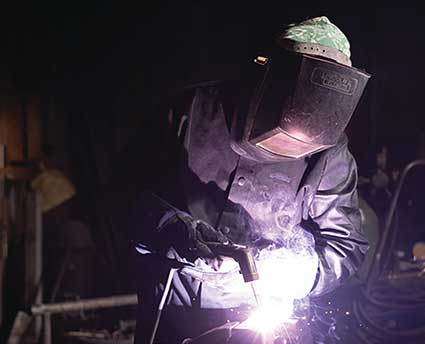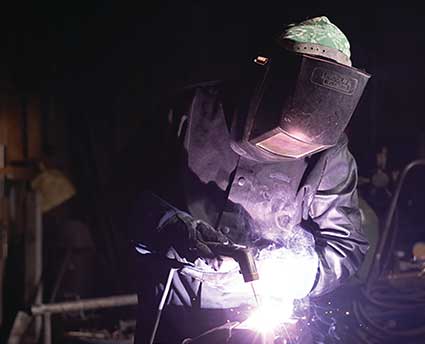Understanding How Flame Resistant Fabrics Work
Flame resistant (FR) clothing is a foundational way to help keep your employees safe and protected from burns caused by flash fires, electric arcs and combustible dust. These hazards can be especially prevalent in many different industries and trades like:
- Oil and gas
- Electrical
- Welding
- Utilities
- Iron and steel
- Mining
Within each profession and industry, the legal requirements for safety workwear vary based on the duties each position entails. Because of these very specific requirements, there are distinct levels of flame resistance protection and a variety of FR fabrics available on the market.
FR Categories and Regulatory Guidelines
The National Fire Protection Association (NFPA) sets the standards and requirements that fire resistance garments must adhere to.
NFPA 70E Requirements
“Standard for Electrical Safety in the Workplace”, known as NFPA 70E, covers electrical safety requirements for workers, focusing on safeguards to remain productive within their respective job functions. The purpose of the standard is to provide “practical safeguarding of employees during activities such as the installation, operation, maintenance, and demolition of electric conductors, electric equipment, signaling and communications conductors.”
In short, NFPA 70E exists to protect electrical workers across all industries who work on or near electricity or energized parts/equipment capable of generating an arc flash.
Complying with NFPA 70E
NFPA 70E is considered the most widely practiced, comprehensive standard for electrical safety in the workplace. Electrical worker FR clothing must comply with these standards, which establishes CAT categories that define the level of arc rating needed by clothing to perform specific hazardous tasks. The standard identifies the distinct types of fire protective clothing needed for specific types of work.
Some of the key garment tests to comply with 70E include:
- Threads must be from flame resistant fibers and not melt at 500°F
- When exposed to flame for 12 seconds, garments:
-
- Must self-extinguish in 2 seconds or less after flame is removed
- Must not have char damage of more than 6 inches
- Must not melt or drip
- Must remain compliant to all these standards after 25 wash and dry cycles
NFPA 2112 Requirements
NFPA 2112 is the clothing standard for protection against flash fire hazards. This requirement is most commonly applicable to non-electrical work found in oil and gas industries, but it does encompass all potential jobs where flash fire is considered a hazard.
The purpose of NFPA 2112 is similar to 70E in that it exists to protect workers from burns caused by hazardous working conditions or materials in the workplace. It provides the minimum requirements “for the design, construction, evaluation, and verification of flame resistant garments for use by industrial personnel.” It intends to reduce burn injuries and the severity of burns for wearers.
The garment requirements laid out in NFPA 2112 are extremely stringent. FR clothing must tested and certified by a third party before being made available on the open market, and garments must defy melting, dripping, or after-flame burning, similar to 70E.
While FR garment designs do sometimes adhere to both standards, it is important to note that compliance with one standard does not mean compliance with the other.
Flame Resistance vs. Flame Retardant Fabrics
While “flame resistance” and “flame retardant” are terms sometimes used interchangeably, there are differences. Flame resistance refers to any fabric where fibers have a natural resistance to burning when exposed to flame. Wool, for example, is highly unlikely to fully ignite because any flames introduced to a wool garment tend to be naturally extinguished by the fibers themselves.
Flame retardant fabrics, on the other hand, are made up of fibers treated by chemicals to make them exceptionally resistant to fire. They can burn, but at a much slower rate than all other fabrics and with the added ability to extinguish themselves.
If a flame is removed from either of these garment types, the fabric will stop burning. This means it will not burn on its own and wearers of these fabrics will have added protection against ignition.
The Science Behind Flame Resistant Fabrics
Some of the leading clothing manufacturers we offer, like DRIFIRE® and SteelGuard®, design, test, and innovate FR clothing by using many types and blends of different fibers to make FR fabrics. Synthetic fibers continue to be a large portion of what comprises FR garments, but everyday fibers like cotton can also become flame resistant when flame retardant chemicals are added.
Nylon and polyester are both popular synthetic fibers that have fire resistant qualities. Plastic-based fibers (like nylon and polyester) tend to melt instead of burn, making them great for FR garment fabrics. Nylon and polyester are both popular materials used in FR clothing due to these high melting points and low thermal conductivity. Manufacturers often treat these synthetic fibers with a fire-resistant chemical for additional protection.
Aramid fibers are another type of synthetic fiber known for their resistance to high temperatures and corrosion. They are also extremely lightweight, yet high strength which make them an excellent fiber for usage in high-performance, FR fabrics. Aramid fibers are known for being stronger than steel at only a fifth the weight of steel.
Modacrylic are synthetic fibers known for their durability, comfort and protection. They have flame retardant qualities, but also are known to be comfortable due to low density of modacrylic fibers. These fibers can be easily dyed, shaped and are known to dry fast. As such, fabrics made with modacrylic fibers are commonly used in performance FR clothing and other workwear.
Cotton, by nature, is not flame resistant. It is highly flammable. However, chemically-treated FR cotton is indeed flame resistant. FR cotton feels and performs much like cotton, but with the added protection against fire making it another common fabric found in FR clothing. Some garments are 100% cotton, yet the flame retardant chemicals make those same garments flame-resistant and able to comply with FR standards. Cotton and nylon fibers are often blended to form a popular flame resistant fabric option for FR clothing manufacturers.
Most FR fabrics are often a specific blend of these kinds of fibers coated with fire-resistant chemicals. The blend ratios and chemical treatments required depend on the application of the garment and which NFPA standards to which it needs to comply.
How Flame Resistant Fabrics Work
How do flame resistant fabrics work? Essentially, FR fabrics are made up of fibers that won’t ignite – often flame retardant fibers, but sometimes a mix of both flame retardant and naturally flame resistant fibers. With all these fibers, both synthetic and natural, FR clothing manufacturers can mix and match different blends to create new and innovative fabrics that increase protection and garment performance, like enhanced moisture wicking, comfort, air flow or durability.
The properties of these fabrics tend to perform well to meet various standard measurements, including:
Self-extinguishing – Garments should extinguish themselves after 12 seconds of flame exposure.
Charring – Most FR fabrics should char (but not burn), which acts to eliminate the fire’s fuel while helping to block the heat from the fire.
Insulating properties – In certain workplace environments, insulating properties are needed to assess how well a garment can protect the wearer from the heat of flames as well as protection in freezing temperatures.
Caring for FR Clothing
FR garments require special safety and care considerations to help the distinct types of FR fabrics retain their flame retardance. NFPA 70E standards state that garments should keep all their FR properties after 25 washes (and dries). But this is only possible if FR clothing is meticulously cleaned. Proper laundering and maintenance are necessary for FR clothing and critical for extending the longevity of the garments so that they keep you and your team safe.
Soils and stains MUST be removed entirely before FR clothing can be used in the field. A small oil stain on your flame resistant coveralls, for example, increases the risk of garment ignition. FR garments must also remain free and clear of other safety-compromising contaminants, like soap residue or calcium and magnesium salt build-up that can build up through washing or hard water.
Proper cleaning of FR garments is a bit more complicated than your standard cotton or polyester clothing items, but a uniform rental service can remove these challenges, shifting the responsibility of cleaning from your team to an experienced professional with established cleaning processes and protocols for FR fabrics.
Benefits of Flame Resistant Uniforms from Vestis
A Vestis uniform rental program helps businesses just like yours save time and money while alleviating the challenges of cleaning, maintaining and managing critical safety apparel. Leveraging a uniform rental program, businesses can improve safety, ensure regulatory compliance and gain peace of mind knowing that all the routine maintenance and upkeep are handled by FR clothing professionals. Read more about the benefits of renting FR clothing and uniforms.
FR Clothing from Vestis
From superior fire protection to enhanced comfort and mobility, Vestis is proud to offer several FR clothing options from the industry’s top manufacturers. We are also the exclusive industrial laundry provider of rental DRIFIRE FR rental garments, a proven leader in the FR industry.
Along the way, we help ensure your facility remains compliant with all the statutory requirements related to flame resistant clothing based on your company’s protection needs. Here is how our FR uniform rental program works:
- A Vestis representative works with you to discuss your overall uniform needs
- We drop off fresh, expertly laundered garments on your scheduled delivery day, or as needed if a unique situation arises.
- We pick up garments at your location and bring them back to our facility for inspection and maintenance.
- We launder your uniforms with a special wash process designed to remove tough stains without compromising the safety or performance of the FR fabrics. We also inspect and maintain your garments, replacing them as needed.
- We monitor inventory levels to make sure you have what you need when you need it.



